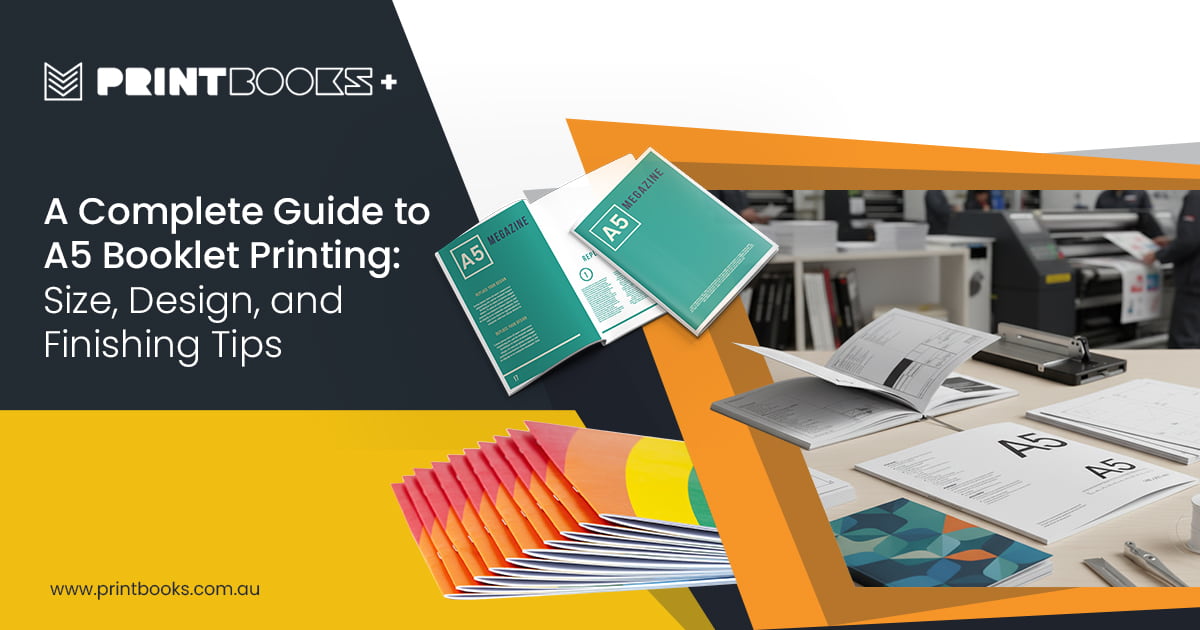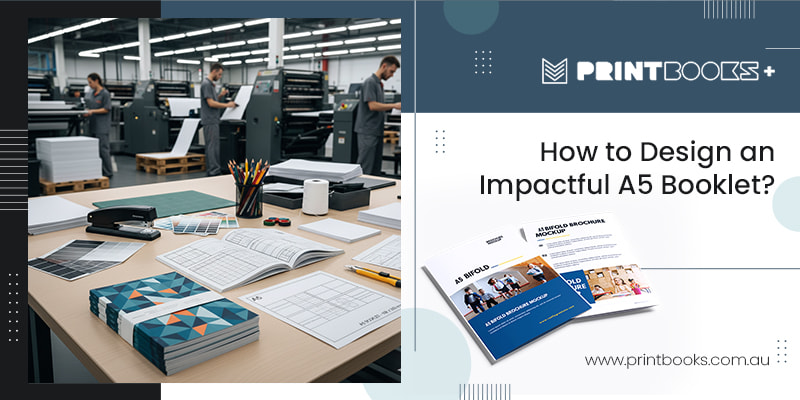A Complete Guide to A5 Booklet Printing: Size, Design, and Finishing Tips

Printed materials hold a firm place, especially when it comes to booklets. According to a 2024 Print Industry Report, 73% of businesses still rely on printed marketing collateral. It includes booklets, for brand storytelling and client communication.
Among all formats, A5 booklets become a versatile favorite.
Why? Because these are compact yet professional and perfect for marketing brochures, product catalogs, event guides or company profiles. Their balance between portability and readability makes them ideal for both businesses and creatives.
Understanding the A5 Booklet Size
Before understanding design or layout, it is crucial to know what defines an A5 booklet.
- A5 Dimensions: 148 mm × 210 mm (or 5.8 × 8.3 inches)
- Page Setup: Usually made from A4 sheets folded in half
- Common Page Counts: 8, 12, 16, 20, 24, or 32 pages — always in multiples of four
This compact size makes A5 booklets ideal for:
- Product catalogs
- Training manuals
- Portfolios
- Event programs
- Instructional guides
- Annual reports
- Travel or hospitality brochures
Compared to larger formats like A4, the A5 booklet offers a 30–40% cost saving in printing and is more convenient to distribute at trade shows, conferences, or direct mail campaigns.
Why Choose A5 Booklets for Your Business?
There are several reasons why A5 booklets have become a marketing favorite across industries:
Perfect Balance Between Portability and Readability
Unlike A6 leaflets (which can be too small) or A4 catalogs (which can be bulky), A5 offers the right balance, spacious enough for visuals and text, yet small enough to slip into a bag or envelope.
Cost-Effective Marketing Tool
Printing A5 booklets costs less due to smaller paper sizes, reduced ink usage, and lighter postage weight. According to Printweek UK, A5 booklets can be up to 50% cheaper to mail compared to A4 counterparts.
Professional and Versatile Appearance
An A5 booklet looks polished and modern. It is compact, clean and easy to handle, projecting an image of professionalism and attention to detail.
High Retention Value
Printed materials are known to have longer shelf lives. A study by Two Sides Global found that people spend an average more time reading print compared to digital, making booklets a great medium for storytelling and brand reinforcement.
Planning Your A5 Booklet: The Foundation
Step 1: Define the Purpose
Ask yourself, what is your booklet meant to achieve?
It could be:
- Introducing a new product line
- Providing a service overview
- Educating customers
- Offering event information
Defining the goal will influence your design style, tone and content layout.
Step 2: Know Your Audience
Tailor your content to who will be reading it.
For example:
- For corporate clients, keep it minimalistic with a clean layout and professional language.
- For creative audiences, experiment with colors, typography and illustrations.
Step 3: Structure Your Content
A clear structure ensures readability.
Consider this layout:
- Cover page – Eye-catching title, brand logo, and key visual.
- Introduction or message – Brief overview or welcome note.
- Core content – Product details, services, or information sections.
- Testimonials or case studies – Real-world credibility.
- Call-to-action page – Contact details or next steps.
Remember: Consistency in layout builds reader trust and enhances flow.
How to Design an Impactful A5 Booklet?

Design is what transforms a booklet from “ordinary” to “memorable.” Here is how to get it right:
Focus on Visual Hierarchy
Your audience’s attention spans average 8 seconds, according to Microsoft’s attention study.
That means every page should guide the reader naturally from headlines to visuals to body text.
- Use bold headers and subheaders.
- Keep text in short paragraphs (no more than 3–4 lines each).
- Incorporate icons, infographics and white space to maintain balance.
Choose the Right Font
Typography defines readability and tone.
- Sans-serif fonts (e.g., Helvetica, Lato) work best for modern and minimal designs.
- Serif fonts (e.g., Times New Roman, Garamond) evoke tradition and reliability.
- Maintain consistency and limit yourself to 2 font families.
Keep body text at 10–11 pt for comfortable reading.
Play Smart with Colors
Color psychology plays a vital role in brand communication:
Blue:
Trust, professionalism (ideal for finance, IT, or corporate firms)
Green:
Growth, sustainability (great for environment-related industries)
Red:
Excitement, urgency (perfect for promotions)
Black & White:
Elegance and simplicity
Ensure your color palette aligns with your brand identity and remains consistent across pages.
Use High-Quality Images
Low-resolution images can ruin an otherwise beautiful design.
Always use:- 300 DPI resolution for print
- CMYK color mode (not RGB) for accurate color reproduction
Stock photos can be useful, but original photography adds authenticity.
Maintain Margins and Bleed
Professional printing requires setup precision:
Margins:
Keep at least 5 mm from the edge.
Bleed area:
3 mm to avoid cutting off elements.
Safe zone:
Ensure no important text or logos fall outside.
Choosing Paper and Print Options
Your choice of paper determines the tactile and visual appeal of your A5 booklet.
Paper Type
Matte:
Smooth, non-reflective, gives a subtle premium feel. Ideal for corporate materials.
Gloss:
Enhances colors and photographs, suitable for vibrant designs or product catalogs.
Silk:
Balanced option — less shine than gloss but smoother than matte.
Paper Weight (GSM)
120–150 GSM:
Light, economical (good for event programs or manuals)
170–200 GSM:
Standard professional weight
250+ GSM:
For covers or luxury prints
Using heavier stock for covers adds durability and perceived value.
Binding Options for A5 Booklets
Binding determines how your booklet will look, feel, and last. Choose based on your purpose and page count.
Saddle Stitching
Description:
Staples along the spine.
Best for:
8–48 pages.
Advantages:
Cost-effective, professional finish, lays flat.
Perfect Binding
Description:
Pages glued to the spine (like a paperback).
Best for:
40+ pages.
Advantages:
Premium look, strong durability, printable spine for titles.
Wiro or Spiral Binding
Description:
Metal or plastic wire holds pages together.
Best for:
Manuals or notebooks.
Advantages:
Opens fully flat, easy to handle.
Finishing Touches That Enhances Your A5 Booklet
Finishing options add flair and enhance tactile experience — helping your booklet stand out.
Lamination
Protects covers and adds texture:
Gloss Lamination:
Shiny and vibrant
Matte Lamination:
Soft-touch, sophisticated feel
Soft-Touch Lamination:
Velvety premium finish
Spot UV
Adds a glossy highlight to specific areas (like logos or headlines), creating a striking contrast.
Foil Stamping
Metallic foil accents (gold, silver, rose gold) add luxury and depth.
Embossing/Debossing
Gives a 3D texture to specific design elements — ideal for logos or brand names.
Die-Cutting
Custom cut-outs on the cover for a creative and interactive look.
Each finishing technique enhances brand perception, studies show premium finishes can increase perceived value by up to 30%.
Sustainability in Booklet Printing
With environmental awareness growing, sustainability is now a major factor in print decisions.
- Choose FSC-certified paper sourced responsibly.
- Use soy-based or water-based inks for eco-friendliness.
- Opt for digital printing for small batches — it reduces waste by up to 40%.
A study by Canon (2023) found that 62% of consumers prefer brands that use sustainable print materials, making it not just ethical but also good business practice.
Final Thoughts
A5 booklet printing is more than just a format choice, it is a strategic branding tool. Whether you’re showcasing products, narrating your brand story, or creating educational content, the right blend of design, paper, and finishing can make your booklet a lasting impression.
When designed thoughtfully and printed professionally, an A5 booklet can communicate more than information, it conveys credibility, craftsmanship and connection.
So, the next time you plan your marketing collateral, don’t underestimate the power of a well-designed A5 booklet, a compact format with a big impact.
